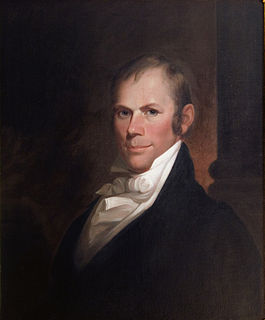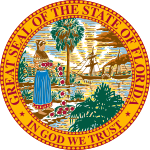
The 2nd United States Congress, consisting of the United States Senate and the United States House of Representatives, met at Congress Hall in Philadelphia, Pennsylvania, from March 4, 1791, to March 4, 1793, during the third and fourth years of George Washington's presidency. The apportionment of seats in the House of Representatives was based on the provisions of Article I, Section 2, Clause 3 of the United States Constitution. Additional House seats were assigned to the two new states of Vermont and Kentucky. Both chambers had a Pro-Administration majority.

The 1992 United States House of Representatives elections coincided with the 1992 presidential election, in which Democrat Bill Clinton was elected as President, defeating Republican incumbent President George H. W. Bush.

The 1982 United States House of Representatives elections was an election for the United States House of Representatives held on November 2, 1982, in the middle of President Ronald Reagan's first term, whose popularity was sinking due to economic conditions under the 1982 recession. The President's Republican Party lost seats in the House, which could be viewed as a response to the President's approval at the time. Unlike most midterm election cycles, the number of seats lost—26 seats to the Democratic Party—was a comparatively large swap. It included most of the seats that had been gained the previous election, cementing the Democratic majority. Coincidentally, the number of seats the Democrats picked up (26), was the exact amount the Republicans would have needed to win the House majority.

The 1964 United States House of Representatives elections was an election for the United States House of Representatives in 1964 which coincided with the election to a full term of President Lyndon B. Johnson. Johnson's landslide victory over Barry Goldwater allowed his Democratic Party to gain a net of 36 seats from the Republican Party, giving them a two-thirds majority in the House. The election also marked the first time since Reconstruction that Republicans made inroads in the deep South.

The 1962 United States House of Representatives elections was an election for the United States House of Representatives in 1962, which occurred in the middle of President John F. Kennedy's term. As in most midterm elections, Kennedy's Democratic Party lost seats to the opposition Republican Party, but retained a majority. House Democrats were expected to lose their majority, but the resolution over the Cuban Missile Crisis just a few weeks prior, led to a rebound in approval for the Democrats under President Kennedy.

The 1952 United States House of Representatives elections was an election for the United States House of Representatives in 1952 which coincided with the election of President Dwight Eisenhower. Eisenhower's Republican Party gained 22 seats from the Democratic Party, gaining a majority of the House. However, the Democrats had almost 250,000 more votes (0.4%) thanks to overwhelming margins in the Solid South. This would be the last time the Republican Party won a majority in the House until 1994. It was also the last election when both major parties increased their share of the popular vote simultaneously, largely due to the disintegration of the American Labor Party and other third parties. As of 2021, this is the last time the House changed partisan control during a presidential cycle.

The 1944 United States House of Representatives elections were elections for the United States House of Representatives in 1944 that coincided with President Franklin D. Roosevelt's re-election to a record fourth term.

The 1942 United States House of Representatives elections was held in the middle of President Franklin D. Roosevelt's third term.

The 1932 United States House of Representatives elections was an election for the United States House of Representatives in 1932 which coincided with the landslide election of President Franklin D. Roosevelt.

Elections to the United States House of Representatives in 1912 were held for members of the 63rd Congress, coinciding with the election of President Woodrow Wilson.

Elections to the United States House of Representatives were held in 1892 for members of the 53rd Congress, taking place at the same time as the election of Grover Cleveland as President for the second, non-continuous, time, defeating incumbent Benjamin Harrison.

Elections to the United States House of Representatives were held in 1872 and 1873 for representatives to the 43rd Congress, coinciding with the re-election of U.S. President Ulysses S. Grant.

Elections to the United States House of Representatives for the 18th Congress were held at various dates in different states between July 1822 and August 1823 during President James Monroe's second term.

Elections to the United States House of Representatives for the 4th Congress were held on various dates in each state between August 25, 1794, and September 5, 1795 (Kentucky). The election was held during President George Washington's second term.

Elections to the United States House of Representatives for the 3rd Congress were held in 1792 and 1793, coinciding with the re-election of George Washington as President. While Washington ran for president as an independent, his followers formed the nation's first organized political party, the Federalist Party, whose members and sympathizers are identified as pro-Administration on this page. In response, followers of Thomas Jefferson and James Madison created the opposition Democratic-Republican Party, who are identified as anti-Administration on this page. The Federalists promoted urbanization, industrialization, mercantilism, centralized government, and a broad interpretation of the United States Constitution. In contrast, Democratic-Republicans supported the ideal of an agrarian republic made up of self-sufficient farmers and small, localized governments with limited power.

Elections to the United States House of Representatives in Florida for three seats in the 59th Congress were held November 8, 1904, alongside the election for President and the election for governor.

Elections to the United States House of Representatives for Florida's three House seats in the 61st Congress were held November 3, 1908 alongside the election for President and the election for governor.

Elections for four seats in the United States House of Representatives in Florida for the 64th Congress were held November 3, 1914.

The 2016 United States House of Representatives elections were held on November 8, 2016, to elect representatives for all 435 congressional districts across each of the 50 U.S. states. Non-voting members for the District of Columbia and Territories of the United States were also elected. These elections coincided with the election of President Donald Trump, although his party lost seats in both chambers of Congress. The winners of this election served in the 115th Congress, with seats apportioned among the states based on the 2010 United States Census. In October 2015, the House elected a new Speaker, Republican Paul Ryan, who was re-elected in the new term. Democrat Nancy Pelosi continued to lead her party as Minority Leader.
The 118th United States Congress is the next meeting of the legislative branch of the United States federal government, composed of the United States Senate and the United States House of Representatives. It is scheduled to meet in Washington, D.C., from January 3, 2023, to January 3, 2025, during the third and fourth years of Joe Biden’s presidency. The elections of November 2022 will decide control of both houses.














